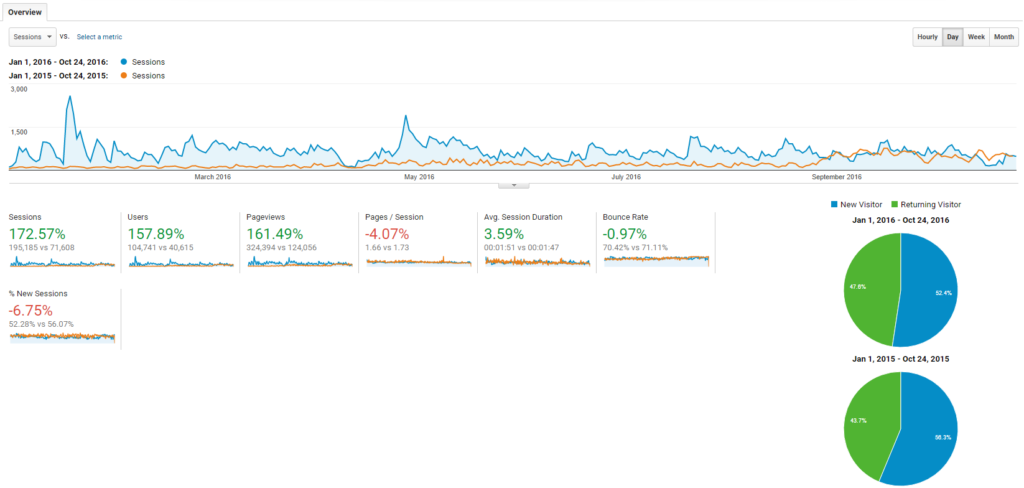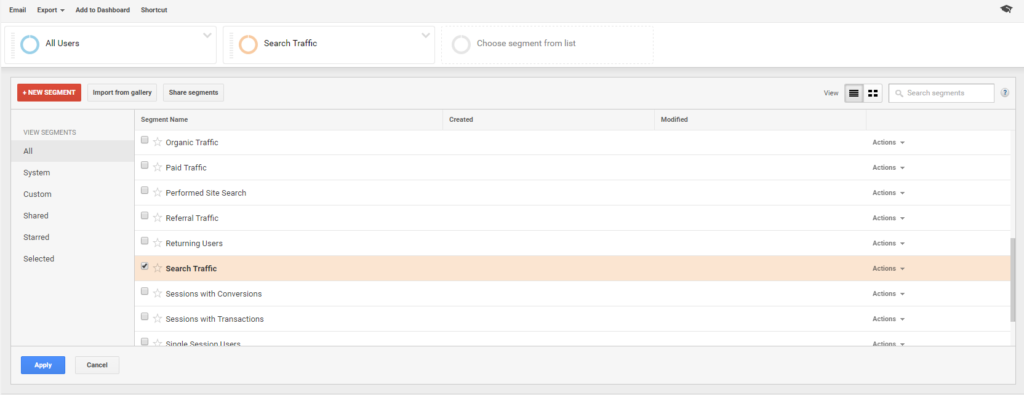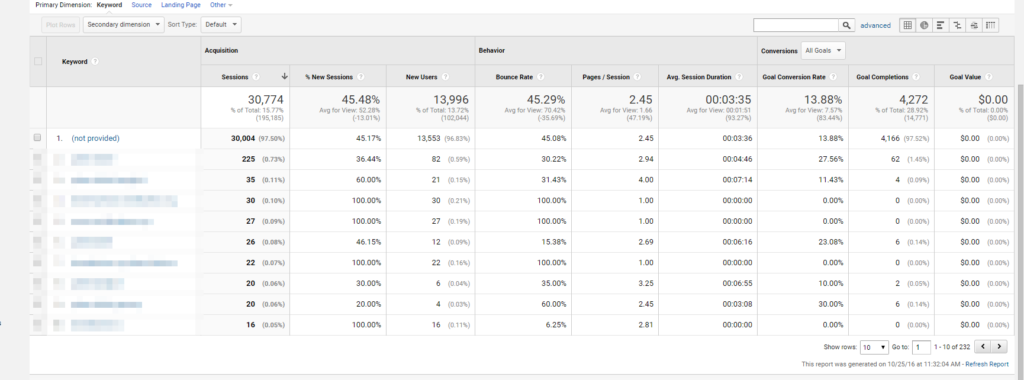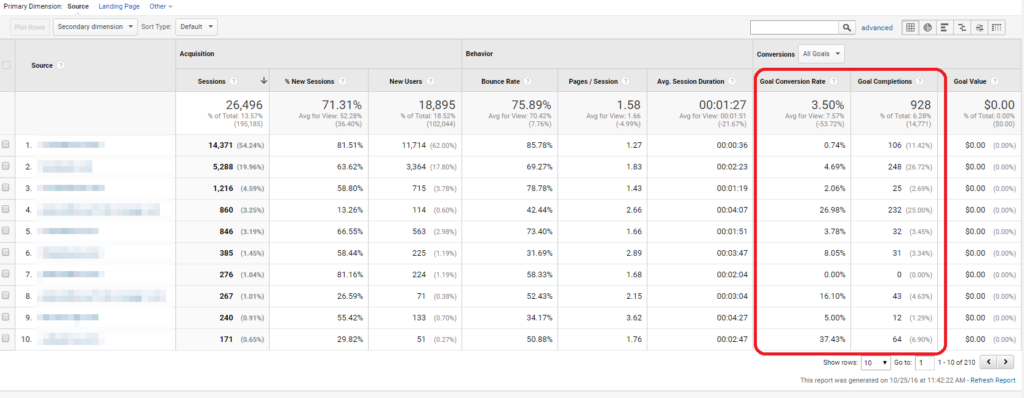As we are coming to the end of 2016, this is about the time most businesses audit their marketing strategy to gauge in which direction their ship has been steering.
There are dozens of metrics you can measure when analyzing your SEO efforts, some being a lot more useful than others. In this article, I will show you how you can measure and improve your 2016 SEO results using Google Analytics.
Have you just started SEO?
If you’ve only started your SEO strategy in the last month or two, it might be a little too early to run an audit as it can take a few months before your website sees any results. If you didn’t notice any positive bump in results, bookmark this article and come back to it in 3-6 months’ time.
Organic search traffic increase
Organic search traffic consists of users who found your website using search. At the base level, you should see how much organic search traffic you received from your last SEO audit to present day.
To do this, log into your Google Analytics and head to Acquisition > All Traffic > Channels. You will be presented with the following channels to choose from:
- Organic Search
- Direct
- Referral
- Social
- (Other)
Select to view ‘Organic Search’ and in the right-hand corner you can choose the dates you wish to compare.

As you can see from the results above, one of my clients has managed to increase their organic traffic by 350%+ in the space of 12 months… not bad, eh ;).
What you can learn: Your organic search traffic will provide you with an overall snapshot of how your SEO strategy is going. To learn what areas are working the best, you’ll have to dig deeper (as shown below).
Visits by website referrals
Checking visits by website referrals is a good indicator of who is linking back to your content. Unlike organic search traffic, more referral clicks on your website isn’t necessarily better.
For the same site above, the sessions are actually lower for 2016 than 2015 based on website referral traffic.

You can view your referral traffic by going to Acquisition > All Traffic > Channels > Referral.
Why shouldn’t you take direct sessions as a measuring point?
Because all websites aren’t equal.
For example, the spikes in sessions in the picture above are from social media. Social media shares do impact SEO, but 1-4 quality back links from high authority sites will do more for your overall SEO than a viral article on social media.
Instead of looking at traffic numbers by referral, focus on how many new websites have linked to your website from your last audit. Run them through Moz Open Site Explorer to gauge their authority.
What you can learn: By measuring their website authority you’ll be able to identify which type of content generates the most back links and social media shares. Focus on creating more of that in 2017.
Website overview
A website overview gives you a snapshot of the following results year on year:
- Sessions
- Users
- Page views
- Pages/sessions
- Avg. session duration
- Bounce rate
- New sessions
You can find these stats by going to Audience > Overview, and you’ll see the following:

What you can learn: If your bounce rate, pages per session, average sessions duration, and new sessions are all lower than your last audit, it could be a sign that the content you’re creating is not good enough, and it’s causing people to leave faster than before.
Do note that by using the overview search, Google Analytics compiles data based on organic search, paid ads, social media, referral, and all other sources. A poor ad campaign can skew these results – add the Search Traffic filter to show results only from search traffic to get your actual SEO results.

Organic keywords
A cool feature in Google Analytics, that very few people use, is the organic keywords section. Here you can learn which keywords users are typing to find your website and how they interact with your website.
You can find organic keywords by going to Acquisition > Campaigns > Organic Keywords:

What you can learn: Look for keywords that have a low website bounce rate and a high average session duration. Enter that keyword into the Google Keyword Planner to find similar keywords you can target in 2017.
For poor performing keywords, view each page and see if you can update the content or if there are any website issues causing users to leave.
What is (not provided)?
When a user makes a Google search using a secure browser, the search term is no longer associated with the search. All searches made using secure browsers are marked as (not provided).
Viewing your conversions
Ultimately, you’ll want to know if your SEO efforts are bringing you monetary results. If you’ve set up Google Goals on your website and Analytics, you can view how individual keywords, back links, and search traffic are performing on your website.

What you can learn: Viewing your conversions by referral can give you ideas on which sites you should be guest posting or trying to obtain white-hat links from. Viewing goal conversions by organic keywords provides data on whether seed keywords or long-tail keywords are more profitable for your business.
Are a certain category of keywords or referral websites bringing you no results?
Cut them from your 2017 SEO strategy and focus your attention on the parts that are working.
How is your website perceived in the eyes of Authority?
You can easily measure all of the above metrics by using Google Analytics. It will provide you with a wealth of information on how your SEO is performing internally.
But to get a total overview of your SEO strategy, you’ll want to use a few external tools, such as:
Google Page Speed Insights – Is your website scoring higher than your last audit? Your score will impact your online visibility in the search.
Open Site Explorer – Is your Page Rank, Moz Rank, and Domain authority greater than your last audit?
You should expect your numbers to increase every audit.
Tip: keep an eye on your spam score, if it gets too high (4/17 or more) you’re most likely doing something wrong.
Pingdom – Is your website faster and more responsive than last time?
Google Search Console – Have you been penalized or are your pages showing any coding errors?
Google Plus – How many views is your account getting per month?
If you have listed your business correctly on maps, this should continually be rising.
These are all important metrics to write down every three months and compare. When making constant changes to your website, your website may become slower, contain coding issues, or increase its spam quality if you’re doing something wrong.
Summary
Depending on how hard you’re pushing your SEO strategy, you should be measuring results every 3-6 months, or month to month if you’re working on it full time.
Whenever you analyze a part of your SEO strategy, ask yourself: “What does this information tell me?”
You analyze to learn and improve.
Once you have analyzed your 2016 SEO success, set yourself KPIs. For example, you could aim to reduce the bounce rate by 5% by increasing quality content, inserting more internal links into content, or providing a smoother website experience for mobiles, etc.
Another one could be increasing new sessions by 15%. This can be achieved by targeting keywords in undiscovered markets to drive a new audience to your website.
What do you think is the most important thing to analyze during an SEO audit?

